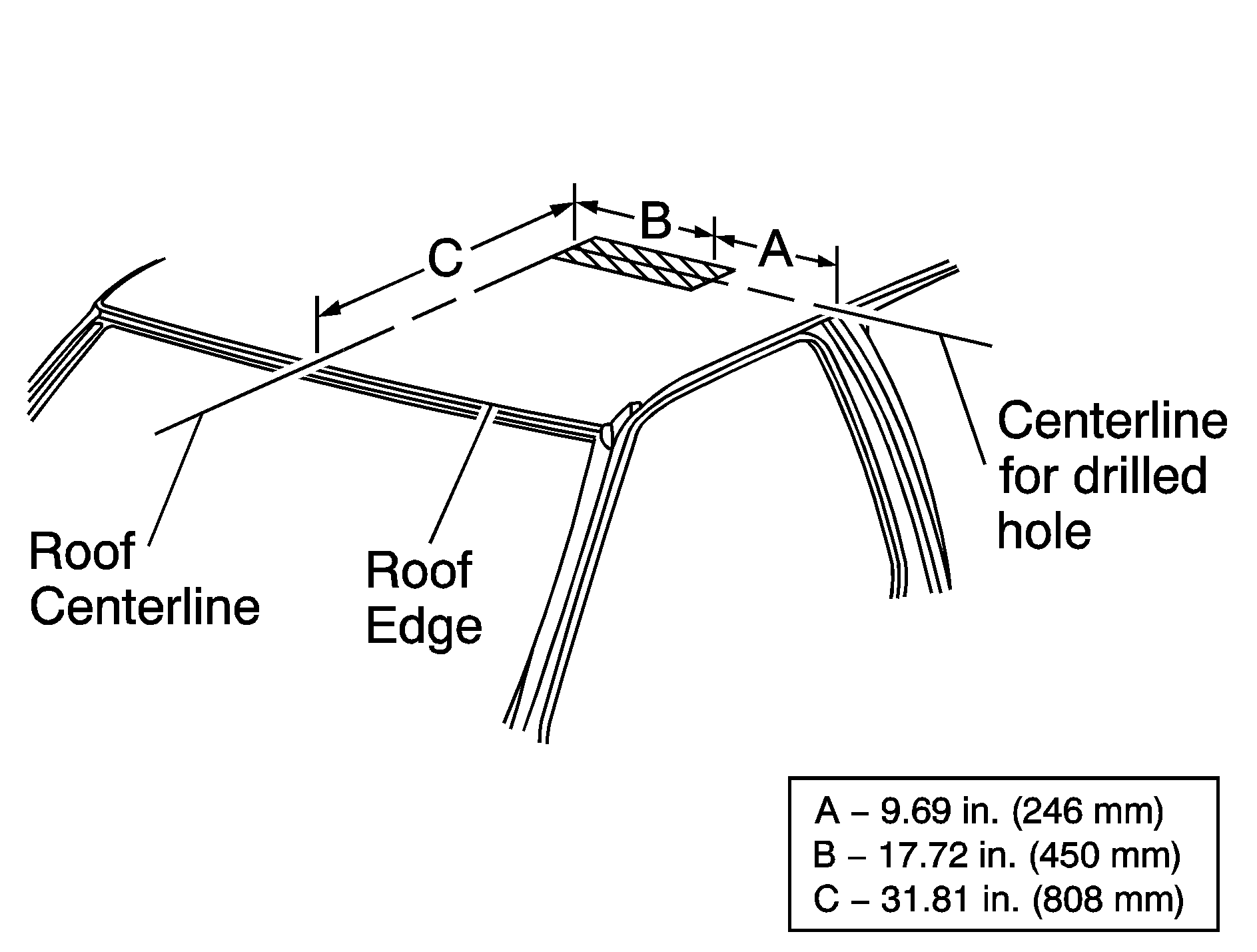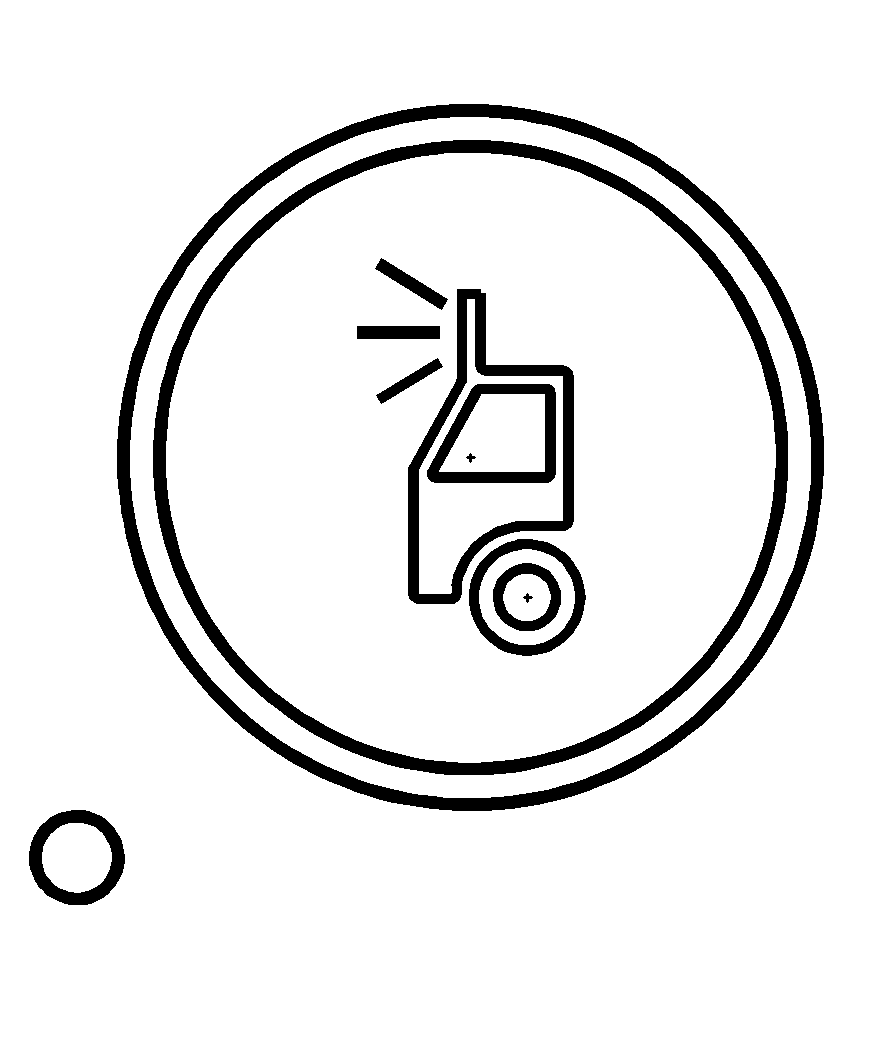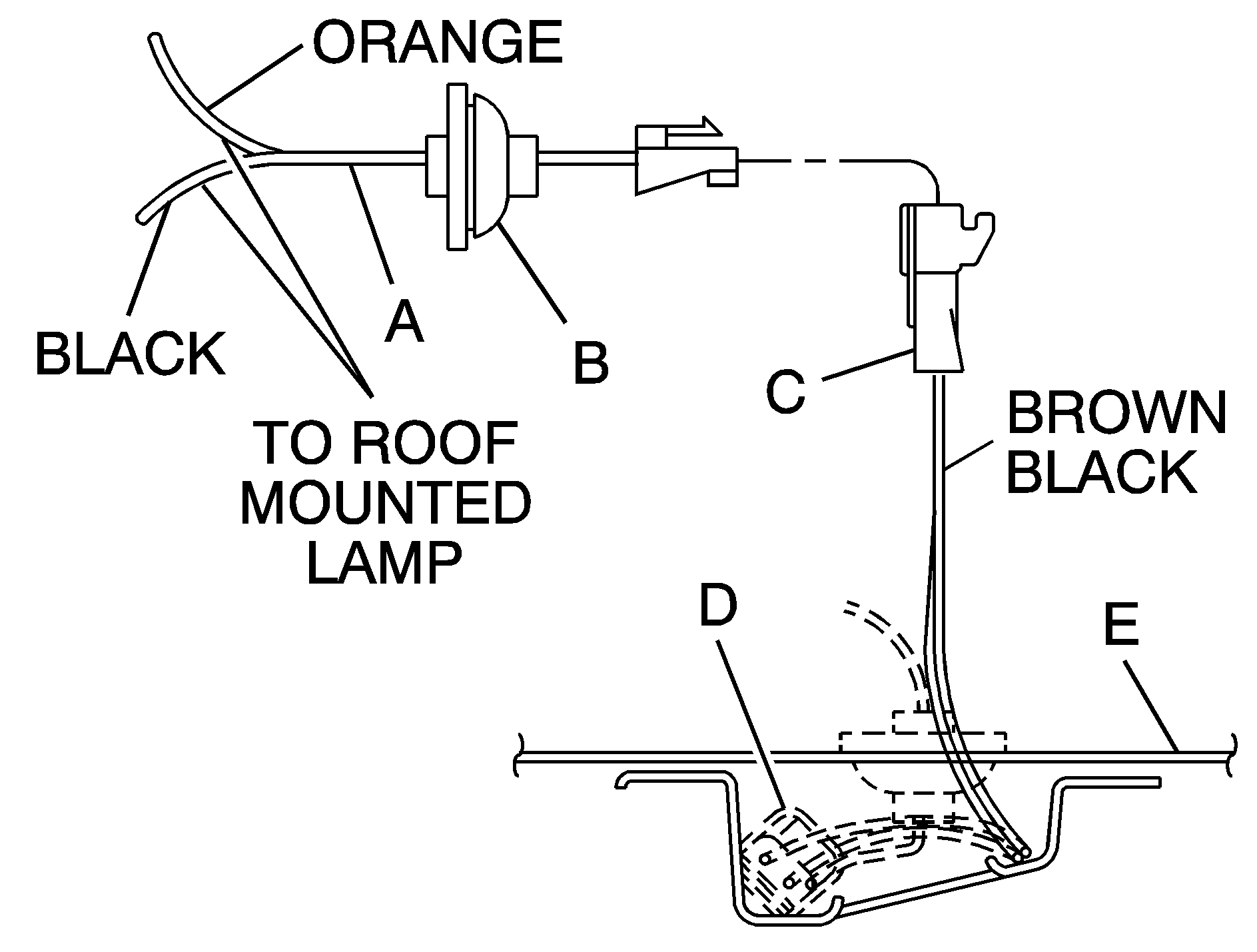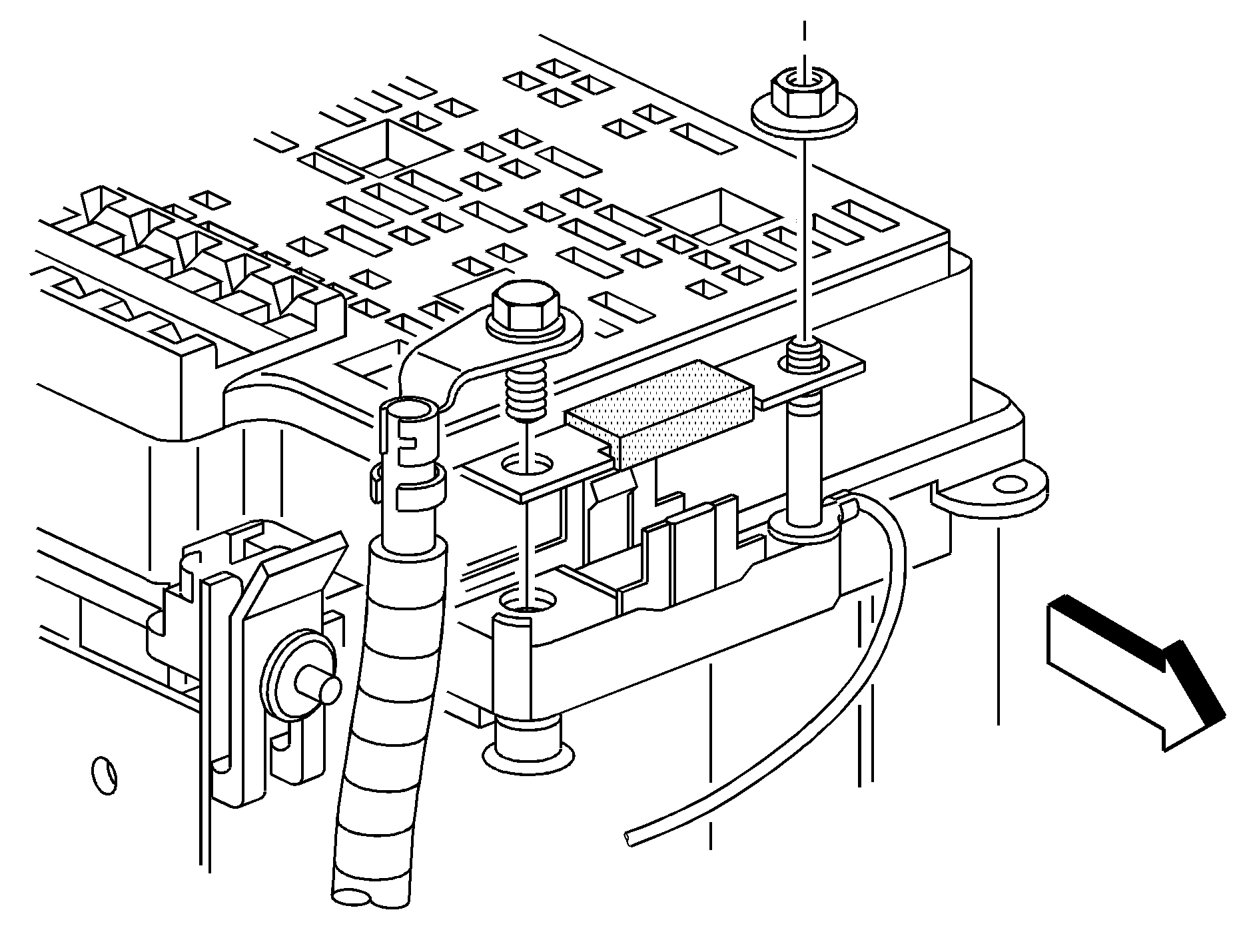Installation Instructions -- Emergency Vehicle Lamp Wiring
Insert Notice SIO#
- Disconnect the negative (-) battery cable at the battery. The negative (-) battery cable must be disconnected before the positive wiring lead is connected to the emergency lamp relay.
- Locate the emergency vehicle lamp connection point under the hood (refer to following illustration). Use the upper stud on the relay mounted at the upper right of front of the dash, in the engine compartment.
- Complete installation of additional fused wiring from the emergency lamp relay to the emergency lamp (refer to following illustration). Use the supplied boot to cover the terminal nut. Torque the nut assembly to 5.5 lb-ft (7.5 N·m).
- With the emergency lamp switch in the off position, reconnect the negative (-) battery cable to the battery. Torque to 12.5 lb-ft (17 N·m).
- Reset the clock time and radio preset buttons as needed.
Terminal for Owner Added Accessory
Retaining Nut, M8
Passenger-side Fender Panel
You can get electrical components from your authorized GM dealer. Many Packard electrical components are also available from Pioneer Standard Company (1-800-PACKARD). Pioneer may also be able to supply customer wiring studs or jumpers made to your specifications.
Owner-Added Accessory Connectors
Use one of the following electrical connection points that will best suit your vehicle's requirements. When possible, it's best to make your accessory (positive) connection at the primary terminal on the MegaFuse block. An alternate connection location is provided by two accessory power studs at the rear of the fuse relay center, located at the rear of the engine compartment on the driver's side. Also, when connecting an owner-added accessory (positive) terminal to a power accessory stud, be sure that the stud nut is fully threaded onto the power accessory stud. After tightening the connection, if the stud is not even with, or threaded past the outer edge of the stud nut, use the next closest power accessory stud to make your connection. Make sure all connections are tight.
Primary Electrical Supply Connection at the Mega Fuse Block
Cover
Nut
Terminal for Owner-Added Accessory
Power Lead used with SEO 9L4 only
Mega Fuse Block
Generator Lead
- Disconnect the negative (-) battery cable at the battery.
- Remove the mega fuse block cover(s). The mega fuse block is located at the front of the engine compartment on the passenger's side, mounted on the rearward side of the upper fan shroud.
- Remove the terminal nut from the lower terminal of the mega fuse holder. Put the positive (+) terminal ring of the accessory on the mega fuse terminal stud. Wiring must be sized correctly. The maximum accessory load is 125 amps on this terminal.
- Reinstall the terminal nut. Tighten the terminal nut to 6-9 lb-ft (9-12 N·m). Reinstall the mega fuse block cover(s).
- Attach appropriately sized ground cable to the battery. Tighten the bolt to 11 lb-ft (15 N·m).
- Connect the negative (-) battery cable to the battery. Tighten the bolt to 11 lb-ft (15 N·m).
- Set the clock time, radio pushbuttons and theft-deterrent feature as needed. See "Audio Systems" in the owner's manual.
Alternate Connection to Vehicle Fuse Relay Center
Alternate Junction Block Cover
Retaining Nut
Owner-Added Accessory (Positive)
Accessory Power Studs
Underhood Fuse Relay Center
- Disconnect the negative (-) battery cable at the battery.
- Remove the alternate junction block cover. The alternate junction block is located on the inner fender at the rear of the fuse relay center on the driver's side.
- Put the positive (+) terminal ring of the electrical accessory on the terminal stud.
- Install an 8 mm terminal nut (GM Part No. 11501085) and tighten the nut to 3 lb-ft (5 N·m). Reinstall the alternate junction block cover.
- Connect the negative (-) battery cable to the battery. Tighten the bolt to 11 lb-ft (15 N·m).
- Set the clock time, radio pushbuttons and theft-deterrent feature as needed. See "Audio Systems" in the owner's manual.
The two 8 mm accessory power studs are individually fused by 30 amp fuses located inside and to the rear of the fuse relay center. Remove the fuse relay center cover if you ever need to check or change the fuses. the maximum accessory load is 21 amps on each power stud.
Installation Instructions -- Emergency Vehicle Roof Panel Lamp
Wiring to the accessory can be done by either directly connecting the wire in the roof to the accessory (Option A) or by using Wiring Harness Package part number 12150250 obtained from GM Service Parts (Option B).

- Disconnect the negative (-) battery cable at the battery.
- Make the electrical connections using either option A or option B.
Notice: Pulling the wiring harness through a panel hole that has sharp edges may cause damage to the wire and/or wire insulation. Remove sharp edges from the panel hole before pulling the wire through it.
Option A: Roof Wires Directly to Accessory
- Drill a 3/8 inch to 1/2 inch (10 to 13 mm) hole in the outer roof panel in the area shown in the illustration. The hole should only go through the outer panel. Remove all sharp edges from the drilled hole.
- Pull out the wiring harness being careful to avoid scraping the insulation on the edge of the hole.
- Extend the wiring harness to the accessory.
- Connect the BROWN wire to the accessory hot terminal.
- Connect the BLACK wire to the accessory ground terminal.
- Cover the hole in the roof with a durable sealant such as silicone rubber sealer.
Notice: If you leave your radio or other accessories on during the jump starting procedure, they could be damaged. The repairs would not be covered by your warranty. Always turn off your radio and other accessories when jump starting your vehicle.
Option B: Use Wiring Harness Package 12150250. Obtain from GM Service Parts through the GM Dealership
- Drill a 1.25 inch (32 mm) hole in the outer roof panel in the area shown. The hole should only go through the outer panel. Remove all sharp edges from the drilled hole.
- Pull out the wiring harness being careful to avoid scraping the insulation on the edge of the hole.
- Cut the wire to length. Install terminals to wire ends and insert into the connector. The BROWN wire goes in cavity A and the BLACK wire in cavity B. Push in the secondary lock to retain the wires.
- Attach the harness assembly from the package to the accessory. Cover with the supplied conduit for added protection. Connect the ORANGE wire to the accessory hot terminal and the BLACK wire to the ground.
- Complete the connection from the roof harness to the extension harness. Cover the mated connector with the supplied foam. Push the foam covered connection and excess wire through the roof panel hole.
Restoring Power

- Be sure that the auxiliary lamp switch is OFF.
- Vacate the vehicle and reconnect the battery cable.
- Turn the auxiliary lamp switch on. The accessory should now be working. If it is not working, check the connections.
- After ensuring that the accessory is working properly, install the grommet in the hole. Seal with silicone sealer to prevent water leakage.
Notice: Overloading the vehicle's electrical system may damage your vehicle's accessories. Do not overload the vehicle's system by having unnecessary accessories on at the same time.
Option B

Harness Assembly
Grommet (Roof)
Harness Connector, Secondary Lock and Terminal
Foam Insulator (Adhesive-Backed)
Vehicle Outer Roof Panel
Maintenance
The circuit is fed from the # 2 post on the underhood electrical center and protected by the fuse labeled "# 2 Post" located in the electrical center. Always replace the fuse with a 30 amp maxi-fuse.
Notice: Before modifying or adding any wiring, be sure that it will work properly with your vehicle's wiring system. Because there are so many modifications that can be made for many different bodies and accessories, GM cannot take responsibility for any changes made. Such changes may not be covered by your GM Warranty. Have the work done by an experienced electrical technician.
All wiring must be properly protected by fuses, etc. and must be routed properly so that it will not be cut, pinched or rubbed by other parts of the vehicle. Do not route wiring in areas where it will be very hot. Be sure not to overload the vehicle's wiring, connectors and components. All added wire must be at least the same size as the wire being attached to for proper fuse protection.Installation Instructions -- 12 Volt Accessory Power Supply
- Disconnect the negative (-) battery cable at the battery. The negative (-) battery cable must be disconnected before the positive wiring lead is connected to the power accessory.
- Locate the power supply harness under the instrument panel near the right side of the vehicle. The wire bundle consists of the pink ignition (IGN) , orange battery (BAT) and black negative (NEG) wire feeds.
- Remove the tape to release the wire bundles from the power supply harness.
- Remove the 40 amp MegaFuse that is taped to the wire bundle. Set aside for installation, after equipment wiring is complete.
- Prepare the wires that are to be used to connect the power accessory. Do not remove the unused wires. Tape unused wires back in their original position under the instrument panel.
- Complete the wiring installation of the customer added accessory with additional wire required for the specific electrical accessory power connection. The wire gage, 12 gage (3.0 mm), should be the same as the wiring of the installed harness.
- The ignition must be turned to OFF or ACC prior to attaching the cables to the battery, or serious damage to the Vehicle Control Module (VCM) may result.
- Disconnect the positive (+) battery cable at the underhood power distribution center. Remove the nut from the 8 mm stud (See illustration).
- Install the 40 amp MegaFuse (from step 4) in the front holder on the underhood power distribution center over the stud. Reinstall the positive (+) battery cable with the mounting screw through the MegaFuse terminal. Replace the 8 mm nut on the stud. Torque both the nut and screw to 1.3-2.7 lb.-ft (6-12 N·m).
- Reconnect the negative (-) battery cable to the battery. Torque the bolt to 12.5 lb-ft. (17 N·m).
- Reset the clock time and radio pushbuttons as desired.
The windshield wiper switch and the radio must be turned off before attaching cables to the battery.
Underhood Power Distribution Center

The IGN A and IGN B connections have voltage supplied and are hot when the ignition is turned to ACC or RUN (pink color wire).
The BAT A and BAT B connections have voltage supplied and are hot at all times (orange color wire).
The combined electrical load of IGN A and BAT A must not exceed 21 amps (250 watts). Additionally, the combined electrical load of IGN B and BAT B must not exceed 21 amps (250 watts). The combined electrical load of all circuits must not exceed 28 amps (340 watts).
